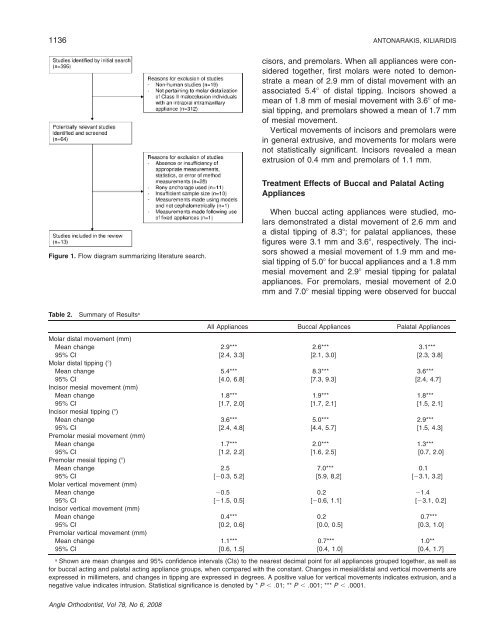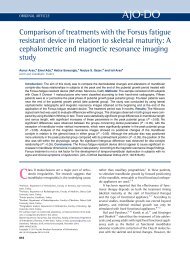appliances occur mechanics) pendulum anchorage evidencebased
Maxillary Molar Distalization with Noncompliance Intramaxillary ...
Maxillary Molar Distalization with Noncompliance Intramaxillary ...
Create successful ePaper yourself
Turn your PDF publications into a flip-book with our unique Google optimized e-Paper software.
Table 2. Summary of Results a All Appliances Buccal Appliances Palatal Appliances<br />
1136 ANTONARAKIS, KILIARIDIS<br />
cisors, and premolars. When all <strong>appliances</strong> were considered<br />
together, first molars were noted to demonstrate<br />
a mean of 2.9 mm of distal movement with an<br />
associated 5.4 of distal tipping. Incisors showed a<br />
mean of 1.8 mm of mesial movement with 3.6 of mesial<br />
tipping, and premolars showed a mean of 1.7 mm<br />
of mesial movement.<br />
Vertical movements of incisors and premolars were<br />
in general extrusive, and movements for molars were<br />
not statistically significant. Incisors revealed a mean<br />
extrusion of 0.4 mm and premolars of 1.1 mm.<br />
Treatment Effects of Buccal and Palatal Acting<br />
Appliances<br />
Figure 1. Flow diagram summarizing literature search.<br />
When buccal acting <strong>appliances</strong> were studied, molars<br />
demonstrated a distal movement of 2.6 mm and<br />
a distal tipping of 8.3; for palatal <strong>appliances</strong>, these<br />
figures were 3.1 mm and 3.6, respectively. The incisors<br />
showed a mesial movement of 1.9 mm and mesial<br />
tipping of 5.0 for buccal <strong>appliances</strong> and a 1.8 mm<br />
mesial movement and 2.9 mesial tipping for palatal<br />
<strong>appliances</strong>. For premolars, mesial movement of 2.0<br />
mm and 7.0 mesial tipping were observed for buccal<br />
Molar distal movement (mm)<br />
Mean change 2.9*** 2.6*** 3.1***<br />
95% CI [2.4, 3.3] [2.1, 3.0] [2.3, 3.8]<br />
Molar distal tipping ()<br />
Mean change 5.4*** 8.3*** 3.6***<br />
95% CI [4.0, 6.8] [7.3, 9.3] [2.4, 4.7]<br />
Incisor mesial movement (mm)<br />
Mean change 1.8*** 1.9*** 1.8***<br />
95% CI [1.7, 2.0] [1.7, 2.1] [1.5, 2.1]<br />
Incisor mesial tipping ()<br />
Mean change 3.6*** 5.0*** 2.9***<br />
95% CI [2.4, 4.8] [4.4, 5.7] [1.5, 4.3]<br />
Premolar mesial movement (mm)<br />
Mean change 1.7*** 2.0*** 1.3***<br />
95% CI [1.2, 2.2] [1.6, 2.5] [0.7, 2.0]<br />
Premolar mesial tipping ()<br />
Mean change 2.5 7.0*** 0.1<br />
95% CI [0.3, 5.2] [5.9, 8,2] [3.1, 3.2]<br />
Molar vertical movement (mm)<br />
Mean change 0.5 0.2 1.4<br />
95% CI [1.5, 0.5] [0.6, 1.1] [3.1, 0.2]<br />
Incisor vertical movement (mm)<br />
Mean change 0.4*** 0.2 0.7***<br />
95% CI [0.2, 0.6] [0.0, 0.5] [0.3, 1.0]<br />
Premolar vertical movement (mm)<br />
Mean change 1.1*** 0.7*** 1.0**<br />
95% CI [0.6, 1.5] [0.4, 1.0] [0.4, 1.7]<br />
a<br />
Shown are mean changes and 95% confidence intervals (CIs) to the nearest decimal point for all <strong>appliances</strong> grouped together, as well as<br />
for buccal acting and palatal acting appliance groups, when compared with the constant. Changes in mesial/distal and vertical movements are<br />
expressed in millimeters, and changes in tipping are expressed in degrees. A positive value for vertical movements indicates extrusion, and a<br />
negative value indicates intrusion. Statistical significance is denoted by * P .01; ** P .001; *** P .0001.<br />
Angle Orthodontist, Vol 78, No 6, 2008






